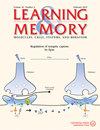An in vitro analog of learning that food is inedible in Aplysia: decreased responses to a transmitter signaling food after pairing with transmitters signaling failed swallowing.
IF 1.8
4区 医学
Q4 NEUROSCIENCES
引用次数: 0
Abstract
An in vitro analog of learning that a food is inedible provided insight into mechanisms underlying the learning. Aplysia learn to stop responding to a food when they attempt but fail to swallow it. Pairing a cholinergic agonist with an NO donor or histamine in the Aplysia cerebral ganglion produced significant decreases in fictive feeding in response to the cholinergic agonist alone. Acetylcholine (ACh) is the transmitter of chemoreceptors sensing food touching the lips. Nitric oxide (NO) and histamine (HA) signal failed attempts to swallow food. Reduced responses to the cholinergic agonist after pairing with NO or HA indicate that learning partially arises via a decreased response to ACh in the cerebral ganglion.
一种在体外类似于学习Aplysia中食物不可食用的方法:在与发出吞咽失败信号的发射器配对后,对发出食物信号的发射器的反应减少。
一种体外模拟学习食物不可食用的方法提供了对学习机制的深入了解。当试图吞咽食物但未能吞咽时,Aplysia学会停止对食物的反应。将胆碱能激动剂与NO供体或Aplysia脑神经节中的组胺配对,可显著减少对胆碱能激动药的模拟进食。乙酰胆碱(ACh)是感知食物触碰嘴唇的化学受体的递质。一氧化氮(NO)和组胺(HA)信号在吞咽食物时失败。与NO或HA配对后对胆碱能激动剂的反应减少表明,学习部分是通过脑神经节中对ACh的反应减少而产生的。
本文章由计算机程序翻译,如有差异,请以英文原文为准。
求助全文
约1分钟内获得全文
求助全文
来源期刊

Learning & memory
医学-神经科学
CiteScore
3.60
自引率
5.00%
发文量
45
审稿时长
6-12 weeks
期刊介绍:
The neurobiology of learning and memory is entering a new interdisciplinary era. Advances in neuropsychology have identified regions of brain tissue that are critical for certain types of function. Electrophysiological techniques have revealed behavioral correlates of neuronal activity. Studies of synaptic plasticity suggest that some mechanisms of memory formation may resemble those of neural development. And molecular approaches have identified genes with patterns of expression that influence behavior. It is clear that future progress depends on interdisciplinary investigations. The current literature of learning and memory is large but fragmented. Until now, there has been no single journal devoted to this area of study and no dominant journal that demands attention by serious workers in the area, regardless of specialty. Learning & Memory provides a forum for these investigations in the form of research papers and review articles.
 求助内容:
求助内容: 应助结果提醒方式:
应助结果提醒方式:


